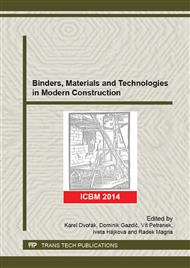p.174
p.178
p.185
p.189
p.193
p.197
p.202
p.207
p.211
Beneficial Reuse of Reservoir Sediments in Concrete Production
Abstract:
This research investigates the potential use of dredged reservoir sediments as a substitute of raw material in concrete production. The first objective is to determine the physical and chemical characteristics of dredged sediments. Based on these sediment characteristics, it appears appropriate to use them as a partial substitute for the natural aggregate in the concrete production. The research results show that concrete mixtures prepared in weight ratio 20 % of coarse-grained sediments as a partial substitute of 0/4 natural aggregate fraction in concrete to 80 % of natural aggregate reached even exceeded the compressive and flexural strengths after 2 and 7 of hardening to those measured in control concrete mixture. After 28 days of hardening, the compressive strength in this mixture slightly decreased (34.44 MPa) in comparison with the control concrete composite (38.30 MPa), while flexural strength measured in the mixture (5.41 MPa) was higher than in control concrete composite (4.93 MPa).
Info:
Periodical:
Pages:
202-206
Citation:
Online since:
April 2015
Authors:
Keywords:
Price:
Сopyright:
© 2015 Trans Tech Publications Ltd. All Rights Reserved
Share:
Citation:


